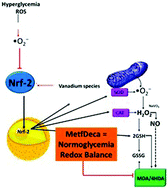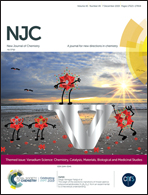Metformin-decavanadate treatment ameliorates hyperglycemia and redox balance of the liver and muscle in a rat model of alloxan-induced diabetes
Abstract
Diabetes mellitus is a pandemic expected to spread from 422 million patients in 2014 to 592 million patients in 2035. Type 1 diabetes mellitus (T1D) is characterized by both autoimmune destruction of beta cells and insulinopaenia, which generates severe oxidative stress in multiple tissues. In this work, we aimed to study both metabolic control and redox balance of the liver and muscle in a model similar to T1D through a temporary treatment with Metformin-decavanadate (MetfDeca). Alloxan (150 mg kg−1; i.p.) was administrated orally to male Wistar rats (300–320 g), Then, six working groups were formed: (1) intact control, (2) untreated group, (3) insulin 1 UI/100 mg dL−1 of glucose per day, (4) metformin 350 mg per kg per day, (5) NaVO3 5 μM/0.1 kg per day, and (6) MetfDeca 3.5 μM/0.1 kg per day. Treatments were administered daily and analysis was performed at 30 and 60 days. In each cohort-time analysis, blood and tissues were collected under experimental conditions (n = 5). Results at day 0 showed glucose levels greater than 300 mg dL−1 and insulin levels smaller than 5 μUI mL−1, and these conditions remained constant during the whole experimental time in untreated animals. Hyperglycemia was associated with increased levels of oxidized glutathione, reactive oxygen species, malondialdehyde, and 4-hydroxyalkenal, which were observed in both the liver and muscle. The antioxidant defense was depleted (superoxide dismutase and catalase activities, and reduced glutathione level). Metformin treatment was ineffective ameliorating hyperglycemia and oxidative stress, whereas metavanadate treatment was moderately effective partially diminishing hyperglycemia and improving the oxidative environment in the muscle. Insulin and MetfDeca treatments ameliorate glucose and insulin levels, and reduce the levels of oxidized glutathione, reactive oxygen species, malondialdehyde, and 4-hydroxyalkenal; the superoxide and catalase activities, as well as glutathione levels were regulated. Therefore, it is suggested that the nuclear factor erythroid 2-related factor was involved. These results allow us to conclude that decavanadate and metavanadate regulated hyperglycemia and oxidative stress through different pathways, probably due to MetfDeca stability and its low intracellular biotransformation, which regulate oxidative stress, antioxidant signaling pathways, and metabolic activities, similarly to insulin.

- This article is part of the themed collection: Vanadium Science: Chemistry, Catalysis, Materials, Biological and Medicinal Studies


 Please wait while we load your content...
Please wait while we load your content...